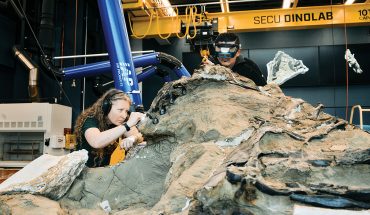
Filmmaker David Hambridge sits in the entrance to his 1973 Airstream trailer where he does much of the editing for his film, The Last Male Standing, about the last surviving male northern white rhinoceros and the dedicated men who care for and protect him.
People Person
A local filmmaker’s take on wildlife conservation
by Jessie Ammons
photographs by Madeline Gray
“This has been an extremely human experience,” says filmmaker David Hambridge. He’s sitting in a bustling coffee shop in downtown Raleigh on a recent afternoon, so absorbed in his laptop he seems a world away. A peek at the screen reveals that he actually is: Shadowed figures walk across the wide horizon of a wildlife conservancy in Kenya, drenched in the rosy hues of waning daylight. The scene is one from his “passion project” in the works, The Last Male Standing, a documentary about the last living male northern white rhinoceros in the world and the men who care for and protect him. “With this, I’m telling the truest story I can. I’ve tried to make this as honest and authentic as possible.”
Hambridge is a Raleigh native who studied film at N.C. State and makes his living creating commercials for companies like Red Hat and Blue Cross Blue Shield NC. He says the documentary is a larger, humanitarian example of the story-driven work he’s built a career on. “I’ve been asked how in the world a guy from North Carolina, let alone Raleigh, gets a story like this,” he says. “I want to open up Raleigh and the local population to feel like they can have an impact and support African wildlife conservation.”

Filmmaker David Hambridge holds his phone as he video chats with James Mwenda who cares for the last surviving male northern white rhinoceros. Hambridge’s film, The Last Male Standing, focuses on the male rhinoceros as well as the men in Kenya who have dedicated their lives to caring for and protecting him.
‘The backdrop’
Hambridge took his first trip to Africa in 2015 to create a film about poaching. He’d been approached by a producer who had seen Hambridge’s commercial work, and together they raised money, put together a film crew, and flew to Kenya. They learned about the five remaining northern white rhinos, a subspecies of the white rhino that had substantially shrunk in just a few decades, the result of illegal hunting largely spurred by ivory demand. During the film crew’s time in Kenya, one of the male northern white rhinos died, leaving only four: three females, all offspring of the one remaining male. Named Sudan, this 44-year-old “teetering rhino” represents the impending end of a subspecies, as white rhinos’ lifespan is typically around 40 years.
From the start, Hambridge and his colleagues knew there was more to the story than the rhino named Sudan. “We were focused on the symbiotic relationship between this one living male northern white (rhino) that people come to see every day, and the rhino caretakers, this band of rangers,” Hambridge says. But he was especially captivated by the rangers. Flying home to Raleigh from Kenya, reflecting on his time there, he says it wasn’t the conservation angle he mulled over, it was the rangers’ storyline. “I left feeling like I had formed a strong bond with those guys and I had to go back.”
He took another trip to Kenya later in 2015, and by this time he’d amicably split with his original film crew, which stayed the course to create a film about “the ivory crisis” caused by poaching species including rhinos. Hambridge, instead, returned to his friends: James, Joseph, and Jacob, the three young men who work full-time to care for Sudan and, Hambridge says, represent the economy built around African wildlife. “If we take away these animals, then these people really don’t have much else to do.” Too often, he says, when someone loses a conservancy-related job they turn to violent or illegal means to support their families, because they don’t believe they have another choice.
The story of the rangers, Hambridge realized, was the story he wanted to tell on screen. “I’m falling in love with these people,” he says. “In making a documentary, you don’t expect that to happen. … That’s why I’m telling this in a very personal, intimate way.” So, while The Last Male Standing is about Sudan the northern white rhino, it’s also about the men who take care of him. Scenes juxtapose the militaristic guards by day, holding rifles to protect the rhino, and by night, making dinner with their wives and their children. “You can understand these people, fall in love with these people, hear their charm and their jokes. This rhino is the backdrop. He is the symbol of extinction.”

Filmmakers David Hambridge, left, and Jesse Paddock, right, who are working on The Last Male Standing about the last surviving male northern white rhinoceros, video chat with one of the film’s Kenyan subjects James Mwenda on Friday, August 4, 2017. Hambridge is currently refurbishing a 1973 Airstream trailer where he often works on editing the film.
Friends forever
The Last Male Standing is still in production, and though there’s no release date yet, Hambridge plans to screen it in Raleigh next month. “I feel a huge responsibility to get it done and get it done right.”
Getting it done right, to Hambridge, means telling a story that goes beyond the headlines. Since Sudan became the last living northern white male rhino, he’s found fame: “On a daily basis there are celebrities from Bollywood going to see Sudan,” Hambridge says. “An actress from American Pie was there while we were there one time. People come in and do the tours and want their picture taken.” One nonprofit even created a Tinder dating app account for the rhino to garner conservation donations. The San Diego Zoo has frozen northern white gene cells to explore in vitro fertilization to save the species.
Meanwhile, Hambridge is dedicated to the story he sees in his friends. That, he says, is when the film will be finished; and that, he believes, is how it will affect change. “People will, I hope, want to do something when they realize that there are some really charming guys that take care of this rhino, they have really bubbly personalities. They really love these animals, and without (the animals), their existence would radically change.”
To do that, he’s secured fiscal support from organizations including the Southern Documentary Fund in Durham, but he still needs more. He hopes to raise funds with his Raleigh screening. And he’s considering how to best wrap the film, most likely in time to release a festival cut this year.
“There’s this voice in the back of my head: ‘Don’t let them down.’ It’s why I’m up really really late some nights. I feel very responsible for this story and about the last male standing.” Ultimately, Hambridge says he has faith that if he directs the film with integrity, the work will speak for itself. “If you have a good story and it’s done well, it will be seen. It will live on.”
To learn more: thelastmalestanding.com



